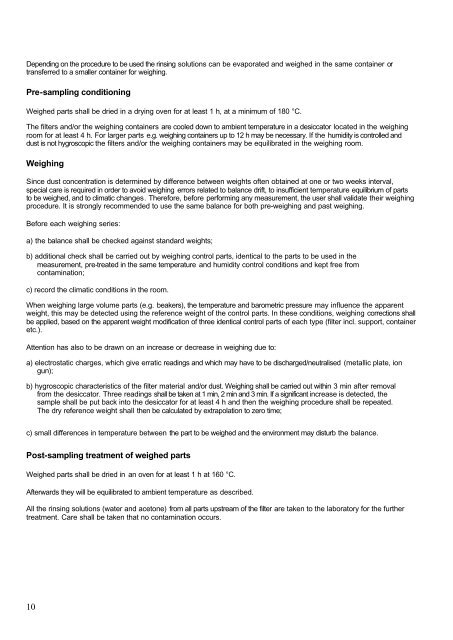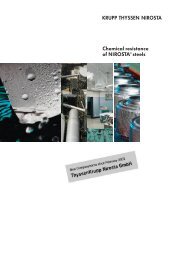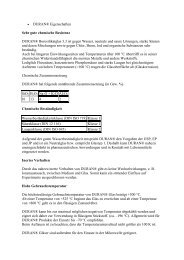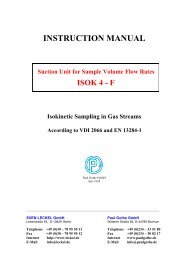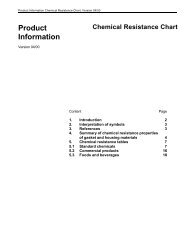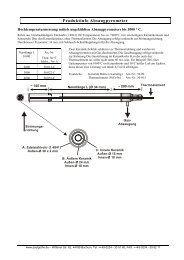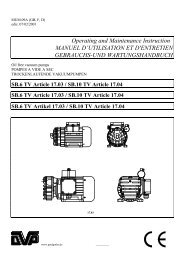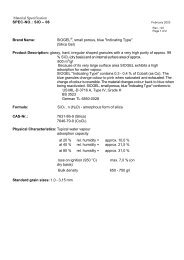Dust-Measurement - Paul Gothe GmbH
Dust-Measurement - Paul Gothe GmbH
Dust-Measurement - Paul Gothe GmbH
You also want an ePaper? Increase the reach of your titles
YUMPU automatically turns print PDFs into web optimized ePapers that Google loves.
Depending on the procedure to be used the rinsing solutions can be evaporated and weighed in the same container or<br />
transferred to a smaller container for weighing.<br />
Pre-sampling conditioning<br />
Weighed parts shall be dried in a drying oven for at least 1 h, at a minimum of 180 °C.<br />
The filters and/or the weighing containers are cooled down to ambient temperature in a desiccator located in the weighing<br />
room for at least 4 h. For larger parts e.g. weighing containers up to 12 h may be necessary. If the humidity is controlled and<br />
dust is not hygroscopic the filters and/or the weighing containers may be equilibrated in the weighing room.<br />
Weighing<br />
Since dust concentration is determined by difference between weights often obtained at one or two weeks interval,<br />
special care is required in order to avoid weighing errors related to balance drift, to insufficient temperature equilibrium of parts<br />
to be weighed, and to climatic changes. Therefore, before performing any measurement, the user shall validate their weighing<br />
procedure. It is strongly recommended to use the same balance for both pre-weighing and past weighing.<br />
Before each weighing series:<br />
a) the balance shall be checked against standard weights;<br />
b) additional check shall be carried out by weighing control parts, identical to the parts to be used in the<br />
measurement, pre-treated in the same temperature and humidity control conditions and kept free from<br />
contamination;<br />
c) record the climatic conditions in the room.<br />
When weighing large volume parts (e.g. beakers), the temperature and barometric pressure may influence the apparent<br />
weight, this may be detected using the reference weight of the control parts. In these conditions, weighing corrections shall<br />
be applied, based on the apparent weight modification of three identical control parts of each type (filter incl. support, container<br />
etc.).<br />
Attention has also to be drawn on an increase or decrease in weighing due to:<br />
a) electrostatic charges, which give erratic readings and which may have to be discharged/neutralised (metallic plate, ion<br />
gun);<br />
b) hygroscopic characteristics of the filter material and/or dust. Weighing shall be carried out within 3 min after removal<br />
from the desiccator. Three readings shall be taken at 1 min, 2 min and 3 min. If a significant increase is detected, the<br />
sample shall be put back into the desiccator for at least 4 h and then the weighing procedure shall be repeated.<br />
The dry reference weight shall then be calculated by extrapolation to zero time;<br />
c) small differences in temperature between the part to be weighed and the environment may disturb the balance.<br />
Post-sampling treatment of weighed parts<br />
Weighed parts shall be dried in an oven for at least 1 h at 160 °C.<br />
Afterwards they will be equilibrated to ambient temperature as described.<br />
All the rinsing solutions (water and acetone) from all parts upstream of the filter are taken to the laboratory for the further<br />
treatment. Care shall be taken that no contamination occurs.<br />
10


